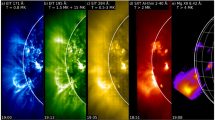Abstract
Near-UV (NUV) Hubble Space Telescope (HST) observations of the extreme hot-Jupiter WASP-12b revealed the presence of diffuse exospheric gas extending beyond the planet’s Roche lobe. Furthermore the NUV observations showed a complete lack of the normally bright core emission of the Mg ii h&k resonance lines, in agreement with the measured anomalously low stellar activity index (logR′ HK ). Comparisons with other distant and inactive stars, and the analysis of radio and optical measurements of the intervening interstellar medium (ISM), led us to the conclusion that the system is surrounded by a circumstellar gas cloud, likely formed of material lost by the planet. Similar anomalous logR′ HK index deficiencies might therefore signal the presence of translucent circumstellar gas around other stars hosting evaporating planets; we identified five such systems and WASP-18 is one of them. Both radio and optical observations of the region surrounding WASP-18 point towards a negligible ISM absorption along the WASP-18 line of sight. Excluding the unlikely possibility of an intrinsic anomalously low stellar activity, we conclude that the system is probably surrounded by a circumstellar gas cloud, presumably formed of material lost by the planet. Nevertheless only a far-UV spectrum of the star would provide a definite answer. Theoretical modelling suggests WASP-18b undergoes negligible mass loss, in contrast to the probable presence of a circumstellar gas cloud formed of material lost by the planet. The solution might be the presence either of an extra energy source driving mass loss (e.g., the reconnection of the stellar and planetary magnetic fields inside the planet atmosphere) or of an evaporating third body (e.g., moon).







Similar content being viewed by others
Notes
Note that this would be true also in case WASP-18 is passing through a period of exceptionally low stellar activity.
References
Amôres, E.B., Lépine, J.R.D.: Astron. J. 130, 679 (2005)
Ben-Jaffel, L., Ballester, G.E.: Astrophys. J. Lett. 785, L30 (2014)
Bisikalo, D.V., Kaygorodov, P., Ionov, D., Shematovich, V., Lammer, H., Fossati, L.: Astrophys. J. 764, 19 (2013)
Brown, D.J.A., Collier Cameron, A., Hall, C., Hebb, L., Smalley, B.: Mon. Not. R. Astron. Soc. 415, 605 (2011)
Doyle, A.P., Smalley, B., Maxted, P.F.L., et al.: Mon. Not. R. Astron. Soc. 428, 3164 (2013)
Duncan, D.K., Vaughan, A.H., Wilson, O.C., et al.: Astrophys. J. Suppl. Ser. 76, 383 (1991)
Fossati, L., et al.: Astrophys. J. Lett. 714, 222 (2010a)
Fossati, L., et al.: Astrophys. J. 720, 872 (2010b)
Fossati, L., Ryabchikova, T., Shulyak, D.V., Haswell, C.A., Elmasli, A., Pandey, C.P., Barnes, T.G., Zwintz, K.: Mon. Not. R. Astron. Soc. 417, 495 (2011)
Fossati, L., Kochukhov, O., Jenkins, J.S., et al.: Astron. Astrophys. 551, A85 (2013a)
Fossati, L., Ayres, T.R., Haswell, C.A., et al.: Astrophys. J. 766, L20 (2013b)
Fuhrmann, K., Axer, M., Gehren, T.: Astron. Astrophys. 271, 451 (1993)
Gray, D.F.: The Observation and Analysis of Stellar Photospheres. Cambridge University Press, Cambridge (2008)
Haswell, C.A., Fossati, L., Ayres, T., et al.: Astrophys. J. 760, 79 (2012)
Hebb, L., et al.: Astrophys. J. 693, 1920 (2009)
Hellier, C., et al.: Nature 460, 1098 (2009)
Jenkins, J.S., Jones, H.R.A., Tinney, C.G., et al.: Mon. Not. R. Astron. Soc. 372, 163 (2006)
Jenkins, J.S., Jones, H.R.A., Pavlenko, Y., Pinfield, D.J., Barnes, J.R., Lyubchik, Y.: Astron. Astrophys. 485, 571 (2008)
Jenkins, J.S., Murgas, F., Rojo, P., et al.: Astron. Astrophys. 531, A8 (2011)
Kalberla, P.M.W., et al.: Astron. Astrophys. 521, A17 (2010)
Knutson, H.A., Howard, A.W., Isaacson, H.: Astrophys. J. 720, 1569 (2010)
Kochukhov, O.: Spectrum synthesis for magnetic, chemically stratified stellar atmospheres. In: Romanyuk, I.I., Kudryavtsev, D.O., Neizvestnaya, O.M., Shapoval, V.M. (eds.) Magnetic Stars 2006, pp. 109–118 (2007)
Kupka, F., Piskunov, N., Ryabchikova, T.A., Stempels, H.C., Weiss, W.W.: Astron. Astrophys. Suppl. Ser. 138, 119 (1999)
Lai, D., Helling, C., van den Heuvel, E.P.J.: Astrophys. J. 721, 923 (2010)
Lanza, A.F.: Astron. Astrophys. 557, A31 (2013)
Lecavelier des Etangs, A., Bourrier, V., Wheatley, P.J., et al.: Astron. Astrophys. 543, L4 (2012)
Li, S., Miller, N., Lin, D.N.C., Fortney, J.J.: Nature 463, 1054 (2010)
Linsky, J.L., Yang, H., France, K., et al.: Astrophys. J. 717, 1291 (2010)
Llama, J., Wood, K., Jardine, M., et al.: Mon. Not. R. Astron. Soc. 416, L41 (2011)
López-Santiago, J., Montes, D., Gálvez-Ortiz, M.C., et al.: Astron. Astrophys. 514, A97 (2010)
Martínez-Arnáiz, R., López-Santiago, J., Crespo-Chacón, I., Montes, D.: Mon. Not. R. Astron. Soc. 414, 2629 (2011)
McClure-Griffiths, N.M., et al.: Astrophys. J. Suppl. Ser. 181, 398 (2009)
Miller, B.P., Gallo, E., Wright, J.T., Dupree, A.K.: Astrophys. J. 754, 137 (2012)
Piskunov, N.E., Kupka, F., Ryabchikova, T.A., Weiss, W.W., Jeffery, C.S.: Astron. Astrophys. Suppl. Ser. 112, 525 (1995)
Ryabchikova, T.A., Piskunov, N.E., Stempels, H.C., Kupka, F., Weiss, W.W.: Phys. Scr. T 83, 162 (1999)
Ryabchikova, T., Fossati, L., Shulyak, D.: Astron. Astrophys. 506, 203 (2009)
Shulyak, D., Tsymbal, V., Ryabchikova, T., Ch, S., Weiss, W.W.: Astron. Astrophys. 428, 993 (2004)
Vidal-Madjar, A., Ballester, G.E., Ferlet, R., Hébrard, G., Mayor, M.: Nature 422, 143 (2003)
Vidal-Madjar, A., Désert, J.-M., des Lecavelier, E.A., et al.: Astrophys. J. 604L, 69 (2004)
Vidotto, A.A., Jardine, M., Helling, C.: Astrophys. J. Lett. 722, L168 (2010)
Wright, J.T.: Astron. J. 128, 1273 (2004)
Wright, J.T., Marcy, G.W., Butler, R.P., Vogt, S.S.: Astrophys. J. Suppl. Ser. 152, 261 (2004)
Acknowledgements
Based on observations made with ESO Telescopes at the La Silla Paranal Observatory under programme ID 092.D-0587(A). Luca Fossati and Dmitry Bisikalo thank the International Space Science Institute (ISSI) in Bern, and the ISSI team “Characterizing stellar and exoplanetary environments”. The authors would like to thank the anonymous referee for the valuable comments and suggestions which led to an improvement of the manuscript.
Author information
Authors and Affiliations
Corresponding author
Rights and permissions
About this article
Cite this article
Fossati, L., Ayres, T.R., Haswell, C.A. et al. Searching for a gas cloud surrounding the WASP-18 planetary system. Astrophys Space Sci 354, 21–28 (2014). https://doi.org/10.1007/s10509-014-2016-6
Received:
Accepted:
Published:
Issue Date:
DOI: https://doi.org/10.1007/s10509-014-2016-6




